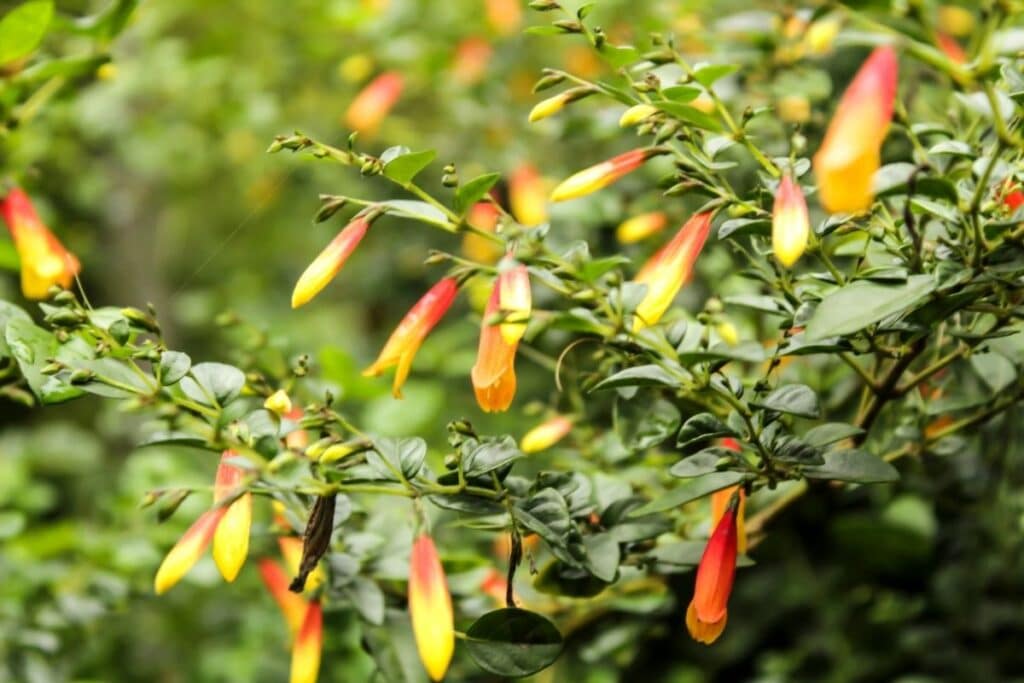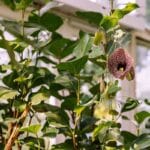A beautiful landscape is filled with plants that complement each other. One of the plants that work well with other existing vegetation is the candy corn plant. Being a good addition to a garden is made possible by the plant’s beautiful yellow and orange flowers that resemble candy corn.
Read on to know how to grow and care for the candy corn plant.
Botanical Information
The candy corn plant or Cuphea micropetala is also known as the Mexican giant cigar plant, cigar plant, firecracker vine, and candy corn. It is under the Lythraceae family.
The genus Cuphea is renowned for its attention-grabbing cylindrical flowers, which exhibit color combinations reminiscent of both cigars and firecrackers.
These vibrant blooms are the primary reason behind the plant’s diverse common names, which can vary depending on the location where it is observed. For a stunning display, consider growing your candy corn plant in a hanging basket.
Spatial Distribution
Under the Cuphea genus, the candy corn plant is one of the 200 species that are native to Mexico. Also, the C. micropetala is often seen near coastal areas and planted in USDA zones 8 through 11. They thrive in the said areas mainly because of the requirements this plant needs.
Growth Habits
The Mexican giant cigar plant grows as a perennial herb or shrub. It extends vertically from 1 to 3 feet and horizontally from 1 to 2 feet. Its texture falls in the middle of rough and soft, making it a good transition to other ornamentals.
Some of the perks of incorporating this in a landscape are being beginner-friendly, attractive to humans and pollinators, and low-maintenance. Moreover, spring is the best time for them to grow and be established for immature ones.
In some cases, they are planted as an annual rather than perennial in colder areas.
Leaves
Its foliage is attached oppositely on a straight and scentless deep red stem. Each green leaf has a smooth texture and slim oval with tapered ends, also known as lanceolate. Also, a leaf extends from 3 to 6 inches in length and less than an inch in width.
During fall, the leaf margins change their color to violet or brick red
Flowers
The main attraction of the candy corn plant is its 1 to 3 inches long trumpet-shaped blooms with deep yellow and orange tones. The bisexual flowers have yellow tips and an orange another half, making them look like candy corn or a cigar.
These bewitching blooms are appreciated for long periods due to their long flowering season, which usually happens around fall and summer. This extended blooming period allows the plant to have more time to be pollinated by butterflies and birds.
Grow and Care Tips
Sun Requirement
Native to tropical and temperate regions, exposure to full sun or partial sun, wherein more than 6 continuous hours are allotted, is the best for the cigar plant. Although, less than 6 hours but more than 3 hours of sun exposure or partial shade is not that bad too. However, flowering and growth will be optimized under full sun.
Water Requirement
The candy corn plant requires moderate amounts of water frequently, 2 to 3 times a week. The frequency will vary depending on the weather. For example, hotter days will require more frequent watering.
On the other hand, ensure that the pot has proper drainage holes, and less frequent watering should be done during cold and rainy days to prevent issues like root rot.
Temperature and Humidity
As a tropical plant, it prefers areas that are warm and humid. The foliage can withstand up to 25 to 30 degrees Fahrenheit, while the roots can survive up to 15 degrees Fahrenheit.
Therefore, cutting back is performed a week before winter. In return, it replenishes the plant and keeps a pleasing appearance.
Soil Requirement
The best moist potting soil for it is well-drained and porous. Occasional dryness benefits the plant during its flowering stages. In terms of soil pH, it prefers acidic soils with a pH of less than six.
Moreover, mixing in some peat moss to the potting soil can enhance its water retention properties. When planting, ensure a minimum distance of 12 inches, but ideally 3 feet or more, depending on how big this plant is ought to be.
Fertilizer Requirement
The application of complete fertilizers will help the soil replenish its nutritional content, which may be done quarterly depending on the signs and symptoms seen on these semi woody shrubs. Moreover, some fertilizers will help the plant develop more flowers or leaves.
Nitrogen-rich fertilizers benefit the production of luscious foliage while phosphorus-rich fertilizers induce better bloom quality and quantity. Furthermore, it is important to be careful of the number of fertilizers applied. Follow the recommended rates stated in the product’s labels to avoid soil toxicity.
Maintenance Activities
As a low-maintenance plant, the Mexican giant cigar plant only requires regular pruning. Removing dead, dry, damaged, and unwanted parts will help the plant retain it’s aesthetic and form.
Also, it helps replenish the plant and induce the growth of new leaves and more flowers, especially when pruned before flowering.
Propagation
Aside from being low maintenance, this plant may be propagated in multiple ways. Some of the common methods of propagation are leaf, root, and stem cuttings. Choosing the right age for the cuttings will require more practice and experience to master.
Stem cuttings are the easiest since the stems falling under are not too mature and not immature is easily observed with its diameter and number of leaves.
Regardless of the planting material to be used, prepare a growing medium that is porous, moist, and well-drained. Also, misting is the recommended watering style for equal distribution of water. This encourages healthy new growth.
Function In the Landscape
In gardens, the candy corn plant is incorporated near patios, pathways, and small areas. They may be directly planted in the garden or planted in containers. The benefit of planting it in plant pots will make it easier to maintain and rearrange when the garden is being redecorated.
Some of the functions it plays in the landscape are accent, border, and hedge. Since the cigar plant is versatile, low-maintenance, and fast-growing, the function of this plant may easily change depending on the landscape design.
The Difference Between Candy Corn Plant, Candy Corn Vine, and Cigar Plant
Two plants are often mistaken as the C. micropetala, C. ignea, and Manettia luteorubra.
The cigar plant or C. ignea is a close relative to the candy corn vine, sharing almost all the same characteristics. However, the flower color differentiates it. C. ignea flowers have a warmer red hue on the tips with deep yellow on the middle and lower parts.
Moreover, M. luteorubra or the candy corn vine may come from a different family and genus, but the resemblance is uncanny. The main difference is the growth habit, wherein the Mexican giant cigar plant is erect, and the candy corn vine is crawling and climbing. This difference will make the two differ in landscape functions.
FAQs
Can you grow a candy corn plant indoors?
Yes, Candy corn plants (Manettia luteorubra) can be grown indoors if provided with the right conditions, including bright, indirect sunlight and well-draining moist soil. They thrive in warm temperatures and high humidity, making them suitable for indoor cultivation in areas with controlled environments.
Why is my candy corn plant dying?
Several factors could cause a candy corn plant to decline, including overwatering, underwatering, inadequate light, pests, diseases, or environmental stressors. Assess the plant’s growing conditions, such as water, light, temperature, and humidity, and adjust accordingly to revive it.
How often do you water a candy corn plant?
Water a candy corn plant when the top inch of soil feels dry to the touch, typically every 1-2 weeks. Ensure proper drainage to prevent waterlogging, which can lead to root rot. Adjust the watering frequency based on environmental conditions such as temperature and humidity.
How do I get my candy corn to bloom?
To encourage blooming, provide bright, indirect sunlight and proper care, including occasional fertilization and pruning for bushier growth.
For more vines to grow, check this list.
References
*image by soniabonetruiz/depositphotos







